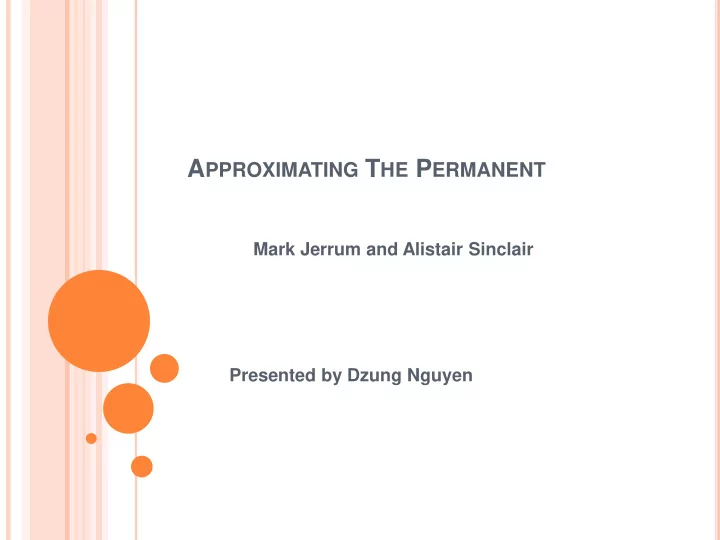

A PPROXIMATING T HE P ERMANENT Mark Jerrum and Alistair Sinclair Presented by Dzung Nguyen
P ERMANENT P ROBLEM A = When Perm(A) = |M(G)| where M(G) is the set of perfect matchings of the bipartite graph G=(U, V, E) with ( , ) iff 1 u v E a i j ij rows 1 1 0 0 1 0 1 1 0 0 0 1 0 1 1 0 columns
O UTLINE Reduction from counting problem to generating 1. problem. Markov Chain and converging speed. 2. Solution 3. Conclusions 4.
U NIFORM GENERATOR AND RANDOMIZED C OUNTER Counting the number of perfect matchings is self- reducible. Let be an arbitrary edge of G. ( , ) e u v ( ) ( \ ) { { } : ( \ { , })} M G M G e M e M M G u v Claim: “If there exist a fully polynomial almost uniform generator of perfect matchings then there exists a fully polynomial randomized algorithm to compute the number of perfect matchings .”
U NIFORM GENERATOR AND RANDOMIZED C OUNTER M(G) Aim: not select e Estimate M(G1) select e M(G1) Estimate ration M(G1)/M(G) Sample t elements of M(G) to count number of elements in M(G1) t is big enough and choose the best G1 which yield maximum ratio
O UTLINE Reduction from counting problem to generating 1. problem. Markov Chain and converging speed. 2. Solution 3. Conclusions 4.
M ARKOV C HAIN AND C ONVERGING S PEED Given a finite state space N, Markov Chain on N is a series of states with transition matrix P. ( ) X 0 t t If the chain is ergodic, denote be the ( ) i i N stationary distribution, the unique vector satisfying P and . 1 i i N The relative point wise distance (r.p.d.) after t steps: t | | p ij j ( ) max t , i j N j An ergodic Markov chain is said to be time- reversible if it satisfies the detailed balance , condition: p p i j N ij i ji j
M ARKOV C HAIN ( CONTINUE ) A time-reversible chain is represented by graph H of |N| vertices with the weight The conductance of a time-reversible chain is defined by:
O UTLINE Reduction from counting problem to generating 1. problem. Markov Chain and converging speed. 2. Solution 3. Conclusions 4.
U NIFORM GENERATOR AND M ARKOV C HAIN Suppose the Markov Chain on the set of elements S is ergodic and uniform distribution when the number of step go to infinite Build a polynomial time almost uniform generator by simulating the chain with large enough t steps. t is poly(|S|) What is the set of elements here? Set of perfect matching? What is the transition matrix?
S OLUTION : S is the set of perfect matchings and near-perfect matchings (two vertices are not matched). In any state , choose an edge uniform ( , ) ( ) e u v E M M G random and then: (i) If M is a perfect matching and , move to state e M ' M M e (ii) If M is a near-perfect matching and u, v are unmatched in M, move to ' M M e (iii) If M is a near-perfect matching, u is matched to w in M and v is unmatched in M, move to ' ( , ) M M e u w ; symmetrically, if v is matched to w and u is unmatched, move to ' ( , ) M M e w v (iv) In all other cases, do nothing. With probability ½, the state moves to itself.
R ESULTS The process is ergodic and time-reversal with uniform stationary distribution. In dense graph i.e. degree of each vertex is at least n/2, the process converges rapidly and at least 1/n 2 elements of S are perfect matching.
C ONCLUSIONS Show the relationship between generating and counting problems. The relationship between the conductance of underlying graph and the converging speed. The technique to prove the lower bound of the conductance. Further: computer the permanent of all 0-1 matrix, matrix with non-negative elements.
Recommend
More recommend